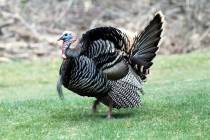Plenty of patience, clucking rewarded in wild turkey hunt
For Calli and Dallin, my youngest daughter and oldest son, their first chance to bag a Rio Grande turkey was an adventure. As their mentor on this junior hunt in Lincoln County last week, my biggest concern was that they at least get a chance to see a gobbler (male turkey), let alone put their tag on one.
Despite waking up at 0-dark-thirty and wearing off boot leather, we had seen and heard nothing that would lead us to believe we were close to finding our quarry.
No tracks. No sign. No gobbles. No wild turkeys.
Then I found one of the things we were looking for -- a blob of green and white turkey poop.
With renewed hope, I pulled the Knight & Hale box call from my jacket pocket and did my best to send sweet nothings over the wild turkey airwaves, rhythmically sliding the paddle over the box in an attempt to get a tom turkey's romantic attention.
Cluck, cluck, cluck, cluck, cluck, cluck! How could any red-blooded American gobbler possibly turn me down? But I got no response, so I tried again -- cluck, cluck, cluck -- and again.
Several minutes and clucks later, Dallin smiled, cocked his head to one side and pointed toward a draw to the north.
"I heard a gobble," he said. Suddenly there it was again -- gobble, gobble, gobble. Despite my aggressive calling tactics, the bird refused to come to us, so we dropped into the draw where we suspected him to be.
Cluck, cluck, cluck! The response was immediate and deliberate. Gobble, gobble! The tom was on his way!
Calli and I took our position in the low-hanging limbs of a small juniper tree. Dallin was tucked into a small opening at the base of a tree 15 feet to our right. Before us was an open area about 40 yards across. With each series of calls, the turkey came closer, and soon two red and blue heads popped up over a small rise on the far side of the opening.
"Two gobblers, two tags. This couldn't be better," I thought as the birds sneaked behind a tree. But with the unexpected roar of a four-wheeler that passed along the road above us, the toms fell silent and disappeared into the trees.
I was angry and disappointed but not about to give up. When the ATV's sound faded, I began to work the call once more.
Cluck, cluck, cluck!
Several minutes passed with no response. My feet and legs were going numb, and I began having thoughts of surrender. But before I could make that mistake, the two gobblers let us know of their renewed intentions to meet the hen I was imitating.
Gobble, gobble!
We could hear the toms as they puffed their feathers and went to strutting just beyond the trees that separated us from them. We even heard them sparring and getting worked up for their pending date. Then they fell silent once more. The four-wheeler was back. Only this time the machine stopped long enough for its rider or passenger to test the turkey airwaves himself. Luckily he couldn't hear the turkeys' calls above the sound of the ATV's motor, and he moved on. But so had the birds.
We had to start over again.
Time dragged as we waited for the anticipated response to our calls. When the response came, only a single gobbler decided to strut his stuff. The problem was he decided to strut behind a big round tree on the far side of the clearing where neither Calli nor Dallin had a clear shot.
When the gobbler finally made his appearance, he was in Calli's shooting lane, so she pulled the 12-gauge into her shoulder and squeezed the trigger. We found the tracks. We read the sign. We heard the gobbles. And Calli bagged a wild turkey.
Doug Nielsen is an award-winning freelance writer and a conservation educator for the Nevada Department of Wildlife. He can be reached at doug@takinitoutside.com.

















